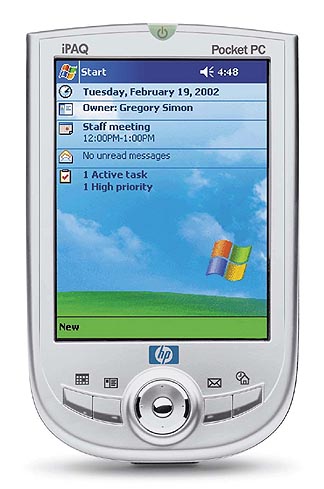HP iPAQ 1910 Pocket PC
HP's new flagship includes Bluetooth, wireless LAN, and even fingerprint identification
(Pen Computing Magazine, March 2003 issue) --
It's been axiomatic that Pocket PCs are always bulkier, more powerful, and more expensive than competing Palm OS devices. Now that HP has subsumed Compaq and is marketing the best-selling iPAQ line under the HP brand, the line is branching out in two clear directions: high-end machines bristling with features like the 5400, and "lifestyle" machines with Palm-like portability, pricing, and (to an certain extent) simplicity. This latter branch is represented in the iPAQ h1910, that is, among other things, the smallest Pocket PC ever shipped.
 The instant appeal of the 1910 is hard to deny. Even Palm diehards are drawn to it. (In fact, our Palm editor Shawn Barnett just waked into my office and asked me to give him this device when I finish my review. He says I owe him one since he gave me his Palm TT, so how can I say no?) What makes the 1910 so irresistible? The clean lines, the slim physique, the smiling row of buttons under the display, the lack of pocket-hostile protrusions -- all are important, certainly. But most of all it is the 1910's eye-poppingly sharp and bright 3.5-inch display. It's a 16-bit reflective part that's comparable to the flagship iPAQ 5400, and it's as notebook-like a display as you'll find anywhere outside of a research lab. Take it outside at noon in the blinding mid-Winter California sun and it still looks great. I'm not going to embarrass myself by saying any more about this display, since it's not proper for a journalist to gush.
The instant appeal of the 1910 is hard to deny. Even Palm diehards are drawn to it. (In fact, our Palm editor Shawn Barnett just waked into my office and asked me to give him this device when I finish my review. He says I owe him one since he gave me his Palm TT, so how can I say no?) What makes the 1910 so irresistible? The clean lines, the slim physique, the smiling row of buttons under the display, the lack of pocket-hostile protrusions -- all are important, certainly. But most of all it is the 1910's eye-poppingly sharp and bright 3.5-inch display. It's a 16-bit reflective part that's comparable to the flagship iPAQ 5400, and it's as notebook-like a display as you'll find anywhere outside of a research lab. Take it outside at noon in the blinding mid-Winter California sun and it still looks great. I'm not going to embarrass myself by saying any more about this display, since it's not proper for a journalist to gush.
But the 1910 has other charms beyond that fabulous display (whoops, I did it again). Unlike the Palm TT and m515, the 1910 has a removable lithium-ion battery pack. This makes the unit more useful to those who spend long periods away from AC. It also increases the useful life of the machine, since the battery is likely to be the first component to poop out over the years.
Performance is just below par due to the use of a 200Mhz Intel PXA250 chip, but most users will never notice. Due to the compact dimensions of the device, a smaller 900 mAH battery was used and the slower clock speed helped keep the unit competitive in terms of time between charge. A fair tradeoff, I'd say.
But wait, there's less.
I've heard it said that a man is rich in direct proportion to the number of things he can do without. While I subscribe to this position, I'm not sure it can be applied equally in all cases. In handheld computers, certain features have become standard issue. For example, one has come to expect a bare minimum of communications options, yet the iPAQ h1910 has none: no expansion jackets, no SDIO support for SD-based Bluetooth and WiFi cards, no modem option, nada. Sure there is the obligatory IR port, but no one really uses those things for communications since performance is dismally slow and keeping the ports lined up is exasperating. The machine is obviously targeted at the consumer/student organizer crowd, people that HP assumes are probably not even aware that PDAs can communicate with the Internet directly. Granted, this device costs about half of what a full-blown communicator/smartphone costs, but I still think the omission of Bluetooth will came back to bite HP. How much would that have raised the retail cost? Fifteen bucks? HP can't seriously imagine that a wireless-capable iPAQ h1910 would cannibalize sales from their top-end iPAQ 5400, a machine that cost three times as much.
But wait, there's less. HP used 16MB of NAND flash, a lower cost form of non-volatile flash memory. Built-in ROM-based applications cannot be executed from it, but must instead be copied into a segregated 16MB section of SDRAM to run, leaving you wish just under 47MB left for storage out of a total of 64MB. To make matters a bit worse, HP loads the device with the Professional, rather than the larger Premium version of Pocket PC 2002 software. You lose the convenience of built-in Windows Media Player, Microsoft Reader, MSN Messenger, and Terminal Services Client. You can still load them in yourself, but that will reduce your available storage space to less than 36MB. You'll find yourself investing in a high-capacity SD card to help with your storage needs.
Another omission is the charging cradle, which you must purchase separately. You can still synch and charge with the provided multipurpose cable, which is festooned with various jacks and adapters to take care of business. I find that cradles are far more convenient to use on a daily basis, and most users will eventually want to buy one. The h1910 cradle does feature a second slot for a spare battery, a useful feature that has finally come over from the mobile phone world.
HP clearly built the h1910 to a price--the fabled US$299 buy-it-without-your-spouses-permission threshold--and they had a specific customer demographic in mind all the while. There is nothing wrong with this approach as long as the resulting product doesn't promise more than it delivers. There is a place for value handhelds even in the generally upscale Pocket PC market. My only concern is that folks who don't carefully read the spec sheet may find themselves wishing they hadn't let low cost, sleek dimensions, and a pretty face lead them to invest in a device they will eventually wish could do more. US$290. - by David MacNeill
Contact: Hewlett Packard www.hp.com
|


 The instant appeal of the 1910 is hard to deny. Even Palm diehards are drawn to it. (In fact, our Palm editor Shawn Barnett just waked into my office and asked me to give him this device when I finish my review. He says I owe him one since he gave me his Palm TT, so how can I say no?) What makes the 1910 so irresistible? The clean lines, the slim physique, the smiling row of buttons under the display, the lack of pocket-hostile protrusions -- all are important, certainly. But most of all it is the 1910's eye-poppingly sharp and bright 3.5-inch display. It's a 16-bit reflective part that's comparable to the flagship iPAQ 5400, and it's as notebook-like a display as you'll find anywhere outside of a research lab. Take it outside at noon in the blinding mid-Winter California sun and it still looks great. I'm not going to embarrass myself by saying any more about this display, since it's not proper for a journalist to gush.
The instant appeal of the 1910 is hard to deny. Even Palm diehards are drawn to it. (In fact, our Palm editor Shawn Barnett just waked into my office and asked me to give him this device when I finish my review. He says I owe him one since he gave me his Palm TT, so how can I say no?) What makes the 1910 so irresistible? The clean lines, the slim physique, the smiling row of buttons under the display, the lack of pocket-hostile protrusions -- all are important, certainly. But most of all it is the 1910's eye-poppingly sharp and bright 3.5-inch display. It's a 16-bit reflective part that's comparable to the flagship iPAQ 5400, and it's as notebook-like a display as you'll find anywhere outside of a research lab. Take it outside at noon in the blinding mid-Winter California sun and it still looks great. I'm not going to embarrass myself by saying any more about this display, since it's not proper for a journalist to gush.